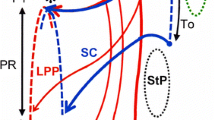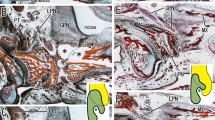Abstract
Purpose
The constrictor pharyngis superior (CPS) initially develops along the posterior wall of the pharyngeal mucosal tube, whereas, during the early phase, the buccinators (BC) are far anterolateral to the CPS. The process and timing of their meeting during fetal growth have not been determined.
Methods
The topographical relationship between the growing BC and CPS was assessed in histological sections from 22 early- and mid-term fetuses of approximate gestational age (GA) 8–16 weeks, and eight late-term fetuses of approximate GA 31–39 weeks.
Results
At 8–9 weeks, the palatopharyngeus appeared to pull the CPS up and forward. Until 11 weeks, the CPS was attached to the hamulus of the pterygoid (pterygopharyngeal part). Until 13 weeks, the CPS extended anterolaterally beyond the hamulus to meet the BC. Some BC muscle fibers originated from the oral mucosa. Notably, by 30 weeks, the CPS-BC interface had become covered by or attached to the palatopharyngeus. Muscle fibers of the palatopharyngeus, however, were thinner than those of the CPS and BC. At and near the interface, BC muscle fibers tended to run along the left–right axis, whereas those of the CPS ran anteroposteriorly. A definite fascia (i.e., a future pterygomandibular raphe) was usually absent between these muscles in fetuses.
Conclusions
The excess anterior growth of the CPS with its subsequent degeneration might cause individual anatomical variations in composite muscle bundles of the palatopharyngeus-CPS complex or palatopharyngeal sphincter. A tensile transduction from the BC to the CPS through the raphe seemed unnecessary for cooperative suckling and swallowing after birth.








Similar content being viewed by others
References
Abe S, Fukuda M, Yamane S et al (2013) Fetal anatomy of the upper pharyngeal muscles with special reference to the nerve supply: is it an enteric plexus or simply an intramuscular nerve? Anat Cell Biol 46:141–148. https://doi.org/10.5115/acb.2013.46.2.141
Cho KH, Lee HS, Katori Y et al (2013) Deep fat of the face revisited. Clin Anat 26:347–356. https://doi.org/10.1002/ca.22206
Ding P, Campbell-Malone R, Holman SD et al (2013) Unilateral superior laryngeal nerve lesion in an animal model of dysphagia and its effect on sucking and swallowing. Dysphagia 28:404–412. https://doi.org/10.1007/s00455-013-9448-y
Doménech-Ratto G (1977) Development and peripheral innervation of the palatal muscles. Acta Anat 97:4–14. https://doi.org/10.1159/000144712
Doyle WJ, Kitajiri M, Sando I (1973) The anatomy of the auditory tube and paratubal musculature in a one month old cleft palate infact. Cleft Palate J 20:218–226
Hayashi S, Hirouchi H, Murakami G et al (2020) Transient connection or origin of the inferior pharyngeal constrictor during fetal development: a study using human fetal sagittal sections. Ann Anat 228:1–8. https://doi.org/10.1016/j.aanat.2019.151438
Holman SD, Waranch DR, Campbell-Malone R et al (2013) Sucking and swallowing rates after palatal anesthesia: an electromyographic study in infants pigs. J Neurophysiol 110:287–296. https://doi.org/10.1152/jn.00064.2013
Huang NHS, Lee ST, Rajendram K (1998) Anatomic basis of cleftbpalate and velopharyngeal surgery: implications from a fresh cadaveric study. Plast Reconstr Surg 101:613–627. https://doi.org/10.1097/00006534-199803000-00007
Kim JH, Yamamoto M, Abe H et al (2017) The palatomaxillary suture revisited: a histological and immunohistochemical study using human fetuses. Okajimas Folia Anat Jpn 94:65–74. https://doi.org/10.2535/ofaj.94.65
Kim JH, Hayashi S, Yamamoto M et al (2020) Examination of the annular tendon (annulus of zinn) as a common origin of the extraocular rectus muscles: 2. Embryological basis of extraocular muscles anomalies. Investing Ophthal Vis Sci 61:1–9. https://doi.org/10.1167/iovs.61.12.5
Klueber K, Langdon HL (1979) Anatomy of musclus levator veli palatini in the 15-week human fetuses. Acta Anat 105:94–105. https://doi.org/10.1159/000145113
Kriens OB (1969) An anatomical approach to veloplasty. Plast Reconstr Surg 43:29–41. https://doi.org/10.1097/00006534-196901000-00006
Miyake N, Hayashi S, Kawase T et al (2010) Fetal anatomy of the human carotid sheath and structures in and around it. Anat Rec 293:438–445. https://doi.org/10.1002/ar.21089
Naito T, Cho KH, Yamamoto M et al (2019) Examination of the topographical anatomy and fetal development of the tendinous annulus of Zinn for a common origin of the extraocular recti. Invest Ophthal Vis Sci 60:4564–4573. https://doi.org/10.1167/iovs.19-28094
Rodríguez-Vázquez JF, Kim JH, Verdugo-López S et al (2011) Human fetal hyoid body origin revisited. J Anat 219:143–149. https://doi.org/10.1111/j.1469-7580.2011.01387.x
Rood SR (1973) The morphology of musculus tensor veli palatini in the five-month human fetus. Am J Anat 138:191–195. https://doi.org/10.1002/aja.1001380205
Sakamoto Y (2015) Spatial relationship between the palatopharyngeus and the superior constrictor of the pharynx. Surg Radiol Anat 37:649–655. https://doi.org/10.1007/s00276-015-1444-5
Shimada K (1979) A study of the morphology of the raphe pterygomandibularis, part 1. The adults. Nihon Univ Dent J 53:998–1007 (in Japanese)
Shimada K, Gasser RF (1989) Morphology of the pterygomandibular raphe in human fetuses and adults. Anat Rec 224:117–122. https://doi.org/10.1002/ar.1092240115
Sumida K, Yamashita K, Kitamura S (2012) Gross anatomical study of the human palatopharyngeus muscle throughout its entire course from origin to insertion. Clin Anat 25:314–323. https://doi.org/10.1002/ca.21233
Sumida K, Ando Y, Seki S et al (2017) Anatomical status of the human palatopharyngeal sphincter and its functional implications. Surg Radiol Anat 39:1191–1201. https://doi.org/10.1007/s00276-017-1855-6
Swarts JD, Rood SR, Doyle WJ (1986) Fetal development of the auditory tube and paratubal musculature. Cleft Palate J 23:289–311
Tsumori N, Abe S, Agematsu H et al (2007) Morphologic characteristics of the superior pharyngeal constrictor muscle in relation to the function during swallowing. Dysphagia 22:122–129. https://doi.org/10.1007/s00455-006-9063-2
Yamamoto M, Hashimoto K, Honkura Y et al (2020) Morphology of the upper esophageal sphincter or cricopharyngeus muscle revisited: a study using adult and fetal specimens. Clin Anat 33:782–794
Yamamoto M, Jin ZW, Hayashi H et al (2021) Association between the developing sphenoid and adult morphology: a study using sagittal sections of the skull base from human embryos and fetuses. J Anat 239:1300–1317. https://doi.org/10.1002/ca.23506
Whillis J (1930) A note on the muscles of the palate and the superior constrictor. J Anat 65:92–95
Williams PL (1995) Gray’s anatomy. Churchill Livingstone, London, pp 1729–1733 (p 796)
Acknowledgements
This study was supported by the Six Talent Peaks Project in Jiangsu province (SZCY-001) and Wuxi Municipal Bureau on Science and Technology (N20202008) in China.
Author information
Authors and Affiliations
Contributions
ZWJ: project development, data analysis, manuscript writing. JHK: data collection, data analysis, manuscript editing. MY: data collection, data management. YK: data analysis. HA: data analysis, manuscript editing. GM: project development, manuscript writing. SA: manuscript editing.
Corresponding author
Ethics declarations
Conflict of interest
The authors have no financial conflict of interest to be declared.
Additional information
Publisher's Note
Springer Nature remains neutral with regard to jurisdictional claims in published maps and institutional affiliations.
Rights and permissions
About this article
Cite this article
Jin, ZW., Kim, J.H., Yamamoto, M. et al. Growth in fetuses of the constrictor pharyngis superior with special reference to its meeting with the buccinator: an embryological basis of adult variations in palatopharyngeal anatomy. Surg Radiol Anat 44, 559–571 (2022). https://doi.org/10.1007/s00276-022-02907-w
Received:
Accepted:
Published:
Issue Date:
DOI: https://doi.org/10.1007/s00276-022-02907-w




